Tall roses for landscape design

When choosing varieties for decorating a plot, a house, a hedge, special attention should be paid to the height of the variety of roses and the frost resistance of the bushes in winter. The highest are of the climbing type
Only remontant varieties give several blooms in one season. The combination of the qualities of these types of roses is typical for the following varieties that are optimal for growing in central Russia:
- Baltimore belle - large clusters of pink five centimeter flowers framed by dark green leaves. The height of the bush is 2 m. Withstands wintering at thirty-degree frost (with high-quality shelter of the root system).
- Bobbie james is a thin curly stem typical of ramblers. In an inflorescence from 35 to 45 flowers with a diameter of 5 cm. Each flower consists of 10-15 petals and a center with bright yellow stamens. The height of the whip is 3 meters.
- Golden wings - elongated yellow buds with bright orange centers grow on a bush that does not exceed 1.5 meters in height. High frost resistance.
- Dortmund - Arcuate shoots with bright red flowers, more like a rose hip in shape. The white stripe of the petal at the center favorably sets off the orange-yellow stamens.
- Lawrence johnston - semi-double yellow flowers grow on arched whips reaching 5 meters in height. The bush grows up to 2 meters wide. The plant has a pungent unpleasant odor.
- Mermaid - the delicate yellowness of the flowers of a winter-hardy plant will delight residents of a temperate climate for a long time. The plant is unpretentious. The height of the bush is 3 meters.
- Rosarium uetersen is an upright bush with massive inflorescences of 15-20 large (12 cm in diameter) pink flowers. The bright pink petals on the back have a silvery tint.
- Flammentanz - bright red, almost burgundy flowers have a strong pleasant scent. They look organic against the background of leathery green leaves of medium saturation. Abundant flowering in early summer. Flowers 8 cm in diameter form inflorescences of 2 to 10 flowers. The height of the bush is from 2.5 to 3 m, winter hardiness is high.
The aforementioned varieties show what colors climbing roses have. There are no less of them than other classes of plants, bred on the basis that nature gave people.
What does the yellow rose symbolize?
The flower of the golden hue is most often associated with people with separation. Still, a yellow rose does not always mean a request to forget about betrayal or parting, such bouquets are given with wishes of fun and joy, and they are also presented as a symbol of the conclusion of peace. Therefore, you should not refuse the yellow roses presented to you because of popular prejudices.
Often, golden flowers are given to artists and outstanding personalities, which is approval and admiration for their gift. As a gift, lemon or amber roses are suitable for girls, as this color is associated with youth and beauty. Mature women are presented with light yellow flowers that emphasize their nobility. The yellow flower symbolizes not only goodbye, but also wealth. In different countries, people associate it with different things, for example, in Japan, this color means happiness and respect.
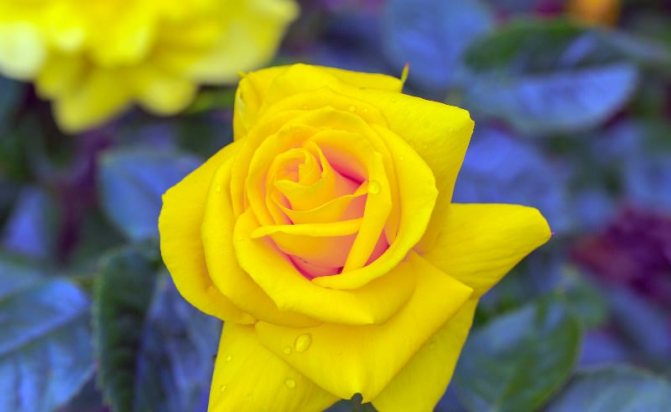
The flower of the golden hue is most often associated in people with separation.
Despite the fact that many are afraid to present yellow roses to their relatives, they buy them for colleagues and celebrities. So, a bouquet of lemon flowers can be presented to a person during a solemn event, thereby wishing him fame and career growth. A lot of yellow roses are a great gift for an anniversary. A catchy and memorable gift is perfect for a colleague, girlfriend or close relative. Do not forget that yellow also symbolizes optimism and has a beneficial effect on the human psyche.
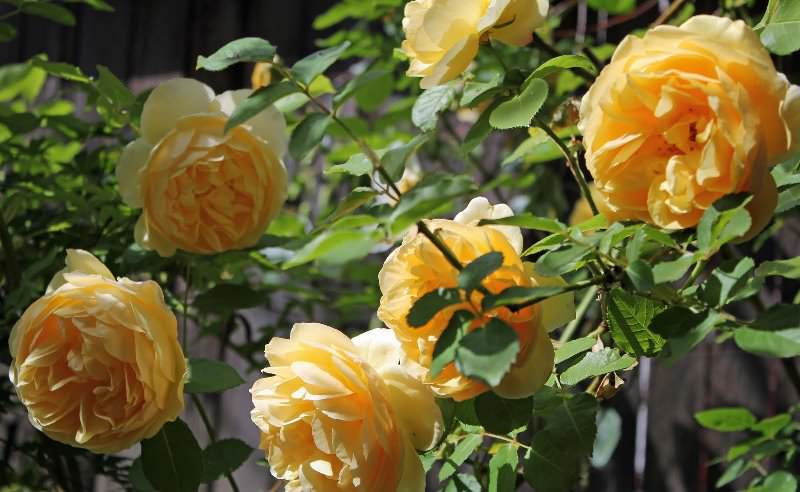
Graham Thomas is distinguished by a unique and pure yellow shade, blooms throughout the summer season
Natural causes of redness
The list of non-pathological origin includes:
- Features of the variety - in some varieties, reddening of the green part is observed in the spring. The anomaly is found in roses with red petals. If the produced pigment has not been completely consumed, then it is redirected by the plant to the foliage.
- Transplant - when transferring a shrub to another area, after moving from a darkened zone to a well-lit one, stress causes the flower to produce additional pigment. Due to its overabundance, foliage and shoots are stained.
- Lack of nutrients - with a lack of nitrogen, reddish spots form on old leaf plates, young ones remain greenish. If the problem is a lack of phosphorus, then a lilac border will be added to the burgundy color, and with a low intake of magnesium, changes will be observed only in the veins. Calcium problems are reported by initial yellowing, and later reddening of the leaves.
Important! When the leaves of a rose turn red what to do first: apply fertilizer. If there are no questions with feeding, then you need to think about treating roses from parasites
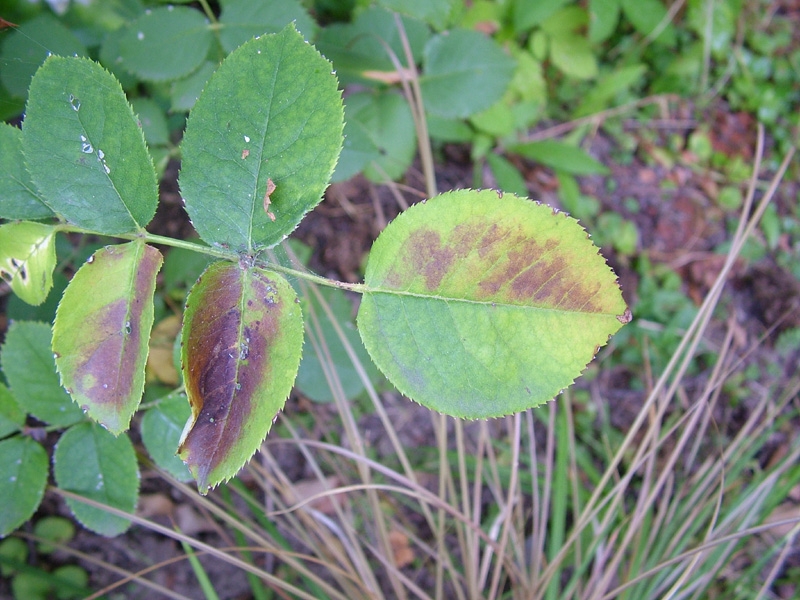
Lack of phosphorus
What to do if a rose bush turns red
Changing colors requires action. What to do if the leaves and stems of the rose turn red:
- Conduct a thorough examination - during hilling, accidental damage could occur, which triggered the penetration of infection into the wounds. If such a place is found, then you need to cover the wound surface with garden pitch or sprinkle with crushed coal powder.
- Watering and feeding according to the schedule - an excess of nutrients and moisture or their deficiency lead to external deviations. In the rain, the flower garden is watered less often (there should be enough water for a long time), the amount of fertilizer is reduced.
- Make a transplant - transferring a shrub to a new site allows you to fight pests and diseases. After the procedure, the plant is sprayed with fungicidal or insecticidal solutions, the damaged stems are cut off.
- Protect from the sun - some species cannot tolerate direct contact with sunlight. You can plant tall trees nearby or create a hedge nearby. If the problem was an overabundance of light, then soon young green foliage will appear on the bushes.
- To study the varietal characteristics of a flower - if only scarlet roses are planted in one area, then there is no need to wait for emerald greenery. The constantly produced red pigment sooner or later migrates to the leaf blades.
Important! In order to avoid redness on the sheet plates, regular inspections and prevention should be carried out. Without timely treatment of the diseased plant, proper fertilization and watering, good results can not be expected
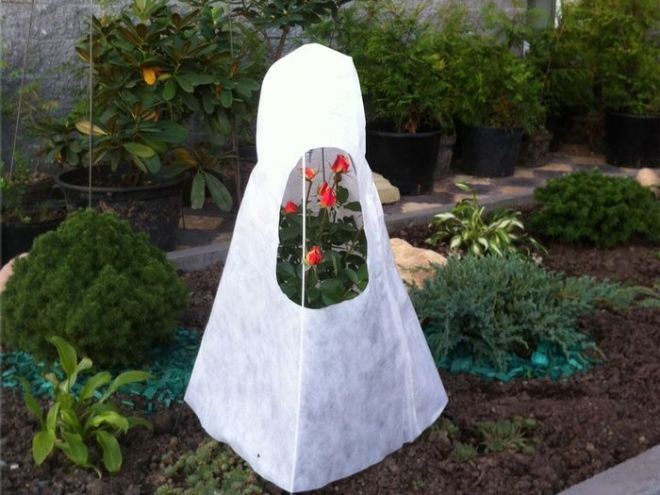
Flower shelter
How to fix the problem and prevent
The solution to the current situation depends on the primary source of its occurrence. Insufficient intake of useful elements is compensated by dressings containing the necessary components. To prevent the development of burn disease on the green part of the bushes, use:
- timely fertilization - the procedure should be carried out before July, later feeding stops (unless there is a case of exception);
- specialized covers - help protect shrubs from summer heat and winter cold;
- spraying - for preventive treatment, a solution of copper sulfate is used.
Fungal infections are more difficult to fight. After determining the type of disease, all damaged areas are cut off, and the cut sites are disinfected with Fundazol or a solution of copper sulfate. Additional measures related to leaving:
- constant monitoring of the amount of fertilizers applied - shortage and excess are equally destructive for the rose garden;
- before planting, the young are kept in a 1% solution of copper sulfate - about 20 minutes;
- plantings are regularly treated with soapy water - this approach will help prevent the formation of colonies of aphids and other parasitic insects;
- when transplanting or processing, do not forget to disinfect the instrument;
- spraying with Bordeaux liquid is periodically carried out;
- they regularly inspect the bushes for damage - if they are found, old and dried shoots are excised.
Upon receipt of all the necessary nutrients, proper watering and planting in a certain place, they practically do not encounter diseases of roses. If a disease has occurred or pests have attacked the bush, then the issue will be easier to resolve. The neglected and unkempt flower beds are more difficult to treat.
The reddish tint of the leaf plates does not always indicate troubles that have arisen. Before starting the process of plant rescue, you need to make sure that the deviation is not associated with stress or varietal characteristics, a lack of mineral elements. In other cases, you will have to treat the entire garden with insecticides and fungicides, change the regime of watering and dressing.
Description of varieties of roses with names and photos
It is almost impossible to create a list of recommended species as all varieties of rose flowers deserve to be included. Further, some varieties of roses with photos and descriptions are offered. Here are some names for rose varieties that you can grow on your backyard.
Photos and short descriptions of rose varieties are offered:

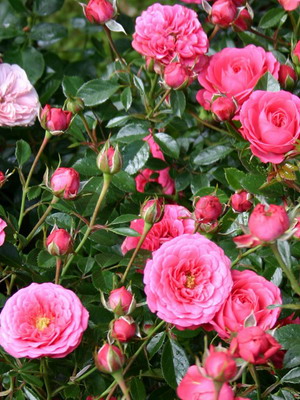
Amulett, syn. "TANtaluma" ("Amulitt") - Min / Miniature. The flowers are terry, spherical, with petals neatly arranged in a circle, rich crimson-pink color. Blooms profusely. The plant is 40-50 cm high.
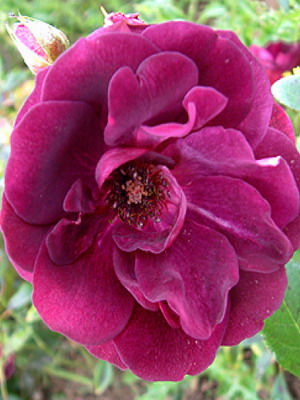
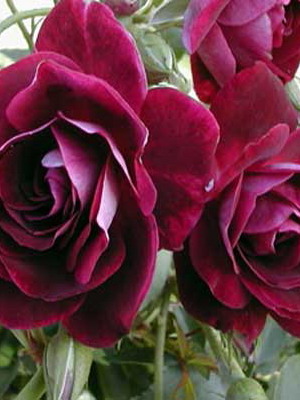
Roses "Burgundy Ice", syn. "PROse", "Burgundy Iceberg" ("Burgundy Ice"), - F / Multi-flowered. The flowers are medium, semi-double, of rare color - dark purple with a tone of Burgundy wine, the reverse is light, silvery. The bush is 80-120 cm high.


Roses "Charles de Gaulle", syn. Meilanein, Katherine Mansfield (Charles de Gaulle) - HT / Noble. A large lilac-lilac flower of a beautiful cupped shape with a strong wonderful aroma. The bush is 80-100 cm high.
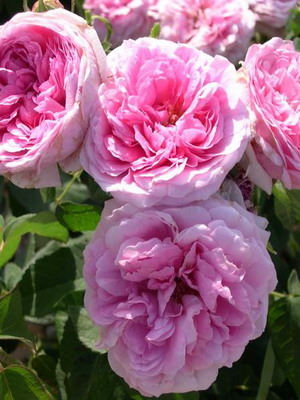
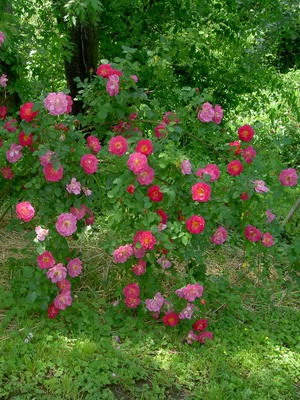
Variety of roses "Comte de Chambord" (Comte de Chambord) - P / Old. This Portland rose has been popular for the third century. The flowers are cupped, densely double, often lodged, pure pink in the center, lighter towards the edges. By the abundance of flowering, it is not inferior to the best modern varieties. The bush is 80-110 cm high.
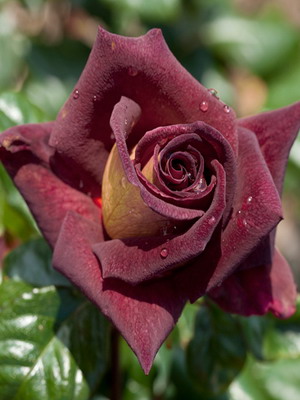

Roses "Eddy Mitchell", syn. "MEIrysett" ("Eddie Mitchell") - HT / Noble. Velvet black cherry flowers with a golden yellow outer side of the petal, large, double, elongated goblet-shaped. The bush is 60-70 cm high.
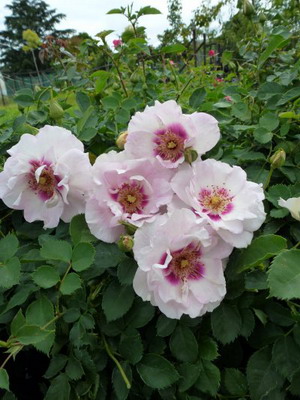
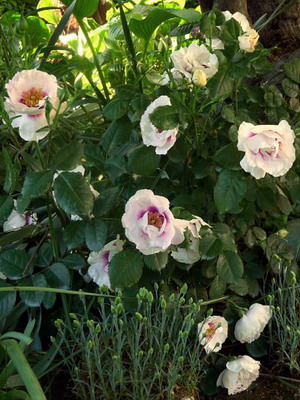
Below you can still see the rose flowers in the photo, which illustrate various varieties.
Roses "Eyes for You", syn. "PEJbigeye", "Pejambigeye" ("Ice fo Yu"), is a hybrid of Hulthemia persica / Multiflorous. A hybrid of chultemia with roses gives it an attractive "zest": purple specks in the center of large open lilac-pink flowers. The height of the bush is 50-75 cm.
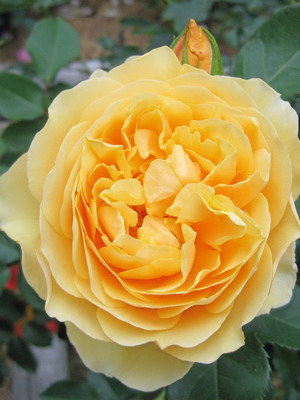

Rose variety "Graham Thomas", syn. "AUSmas" ("Sins Thomas") - S / English. One of the most popular roses in the world. Flexible arched shoots, decorated with round double flowers - yellow "lanterns", create a joyful mood. Growth is highly dependent on conditions and weather, it can reach a height of 2.5 m.
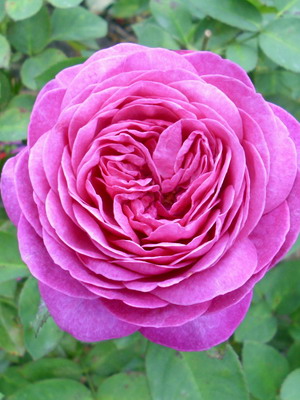
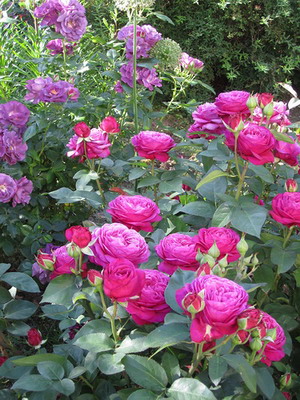
Rose variety "Heidi Klum Rose", syn. "TAN00681", "RT 00681" ("Heidi Klum Rose"), - MinFl / Patio. The flowers are medium-sized, densely doubled, deep purple in color, with a heady aroma. The bush is 40-50 cm high.
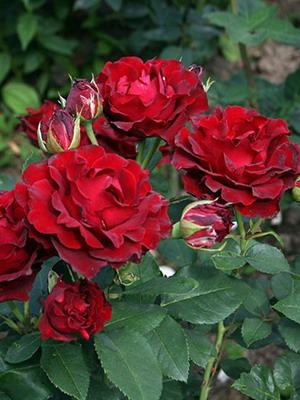

Rose variety "Hommage a Barbara", syn. DELchifrou, "Heinz Winkler" ("Omage a Barbara") - HT / Noble. Single medium-sized flowers of deep red color with a black velvet bloom and curved petals create a unique image. Abundant flowering. The height of the bush is 70-90 cm.

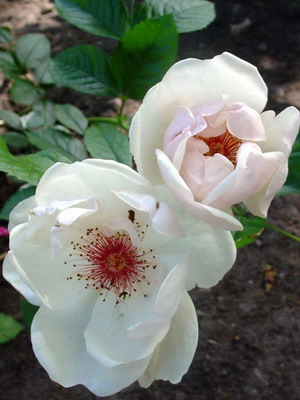
Roses "Jacqueline du Pre", syn. "HARwanna", "Jacqueline de Pre" ("Jacqueline du Pr"), - S / Schrab. Large open semi-double fragrant flowers, white with a pinkish "glow" and long bronze-red stamens, make an indelible impression.The bush is large, 130-160 cm high.


Rose variety "Leonardo da Vinci", blue "MEIdeauri" ("Leonardo da Vinci»), - F / Multi-flowered. Saturated lilac-pink densely doubled lodged large flowers, collected in inflorescences, appear throughout the season. The height of the bush is 80-110 cm.
How to reproduce?
Propagation by cuttings is by far the most common method for roses. However, even under optimal conditions, 90% success is considered an excellent result. The fact is that cuttings do not have enough root system to absorb water and nutrients. Thus, in order to successfully propagate rose bushes, it is required for the grower to create an environment that will support the shoots until they develop enough roots to survive on their own. The best time to take cuttings from plants is early summer. Stems that are not quite young, but also not mature with wilting flowers, fit perfectly. A twig with a bud is too young to reproduce.
The process begins by filling a clean container with a good fertile mixture. It should contain a sufficient amount of organic compounds useful to the plant. Before planting the cutting, the soil is watered, but it should not be too wet, otherwise the rose will simply rot. Select cuttings that are healthy and representative. They are always taken from the top and from the side. Cuttings taken from the middle of the plant do not take root, which remains a mystery to gardeners.
In the next step, flowers or buds are removed, as well as the lower leaves. Cut the remaining leaves in half to reduce moisture loss through transpiration. Using a pencil, make a small hole in the ground, immerse the handle. Cover the top of the seedling with a glass jar or the entire container with a plastic bag to create a greenhouse effect and maintain a high level of humidity. Roses root best in bright light. For this reason, they put containers on the window, but overheating of the cuttings should be avoided. After 3 or 4 weeks, the first roots will appear.
The best varieties of the climbing rose
This species unites all climbing varieties of roses and was bred from two wild growing groups of roses: R. multiflora Thunb and R. wichuraiana Crep. The climbing bush is distinguished by abundant flowering in the second half of summer.
As you can see in the photo, this type of rose has flexible long shoots that spread or rise in an arched manner. Small leaves are tough, and the flowers reach a diameter of 2.2-5 cm, their petals are simple or double. Flowers are collected in large inflorescences. The aroma is weakly fragrant or absent altogether. The color of the petals can be white, pink or red. It blooms once, but for a long time (about 30-35 days). Flowers are located along the entire length of the shoots. Varieties of this type are winter hardiness, and therefore a hard dry shelter is suitable for them.
Recently, there have been many concrete and glass buildings that get very hot in summer, so vertical gardening has become widespread. Climbing rose flowers are recommended to be planted on the south side of buildings, then they will not only serve as a decoration, but also protect it from overheating.
Most of these roses bloom once, and occurs at the beginning of summer, while only last year's branches bloom
Therefore, it is so important for climbing roses to survive the winter well.
Look at the photo of varieties of roses of this type - their beauty will not leave anyone indifferent:
Alberic Barbier has medium-sized yellow buds. The flowers are large, collected in small inflorescences, double petals, creamy yellow, yellow at the edges and in the center. The aroma is fragrant. Shiny, beautifully shaped, dark colored leaves. The climbing bush blooms profusely from June.
American Pillar (American Pillar) - one of the best varieties of climbing roses, which is distinguished by open large flowers, reaching a diameter of 7 cm, collected in large inflorescences and located on strong shoots. The petals of this variety of climbing roses are non-double, carmine pink, the eye is white, the stamens are golden.Leathery leaves are large, shiny. Strong climbing shrub reaches a height of 6 m, blooms profusely from May to June.
Blaze (Blaze) has large cupped flowers, collected in large inflorescences. The petals are semi-double, bright red. The aroma is weakly fragrant. Leaves are leathery. A strong bush with a spreading crown blooms profusely and repeatedly. The variety is propagated by cuttings, grafting and layering.
Feilchenblau has small cupped flowers. The petals are semi-double, bright crimson. The aroma is fragrant.
Gella (Hella) - a variety of roses, characterized by semi-double white flowers, collected in large inflorescences, brushes. Bushes with branches 2.5-3 m long.
Excelsa is a popular variety of roses with red-crimson double flowers and light green, shiny leaves. The bushes are distinguished by long branches - up to 4 m and abundant flowering throughout the month.
Super Excelsa is one of the best varieties of climbing roses with bright crimson petals, collected in large cluster inflorescences. Bushes with branches reaching a length of 4 m.
Dorothy Perkins are small flowers with pink petals. Thin branches of the bushes grow up to 3-5 m in length.
Hybrid Tea White Roses
White roses stand out not only for their excellent color, but also for the fact that they are perfectly combined with any other color of roses. They will decorate any bouquet and harmoniously fit into a wide variety of landscapes and site designs. So the demand for white varietal roses is always high. White rose varieties are subdivided into several varieties according to the type of growth. The best hybrid tea species are presented below.
Photo of a hybrid tea white rose variety Virgo (Virgo)
-
Virgo is an interesting variety of roses. The bushes are vigorous, with a lot of branches. The pagons are straight and long. The buds are semi-double, large, up to 10 cm, snow-white, beautifully shaped. The aroma is moderate, pleasant. It is often grown for cutting.
-
"White Christmas" is a variety originated in the USA. It grows as a compact bush with straight branches up to a meter long. The leaves are always saturated, green. The buds are large, 7-14 cm. Lush, double flowering. The buds have a strong aroma.
- "Snegurochka" is a variety obtained in 1959. The buds are silvery-white, 8-9 cm long, terry type. The bushes are spreading, large. The foliage is dark green, the leaf plate is matte.
Interesting!
Natural rose oil is more valuable than platinum! To obtain a kilogram of this oil, at least 3 tons of petals are required.
Photo of a hybrid tea white rose of the Pascali variety (Pascali)
-
"Pascali" is a Belgian variety of white roses. Unpretentious to care for, resistant to frost. Several years ago he received the distinction as "The most beautiful in the world." Branches are straight, strong, 170-180 cm high. Leaves are fresh, green. The flowers open slowly, very effectively. Initially, they are more creamy than white, but when opened, they become snow-white.
- Winchester Cathedral is a unique variety for those who love lush roses. Its buds are large, beautiful, snow-white in color. The shrub grows up to a meter in height, does not take up much space on the site. Roses have a delicate, almond scent and bloom from the beginning of the season.
It should also include such beautiful varieties as: "Metropolitan", "Kaiserin Augusta Victoria", "Mount Shasta", "Mrs. Herbert Stevens", "White Swan".
The best varieties of burgundy roses with photos
Among the huge assortment of burgundy roses, I would like to highlight the following especially beautiful and unique varieties.
Astrid Grafin von Hardenberg
The exquisite garden rose of German selection Astrid Decanter will top the list. It has won awards at international exhibitions for its delicious scent. Her bush is lush and spreading, reaches a height of 1.5 m. Flowers are formed by inflorescences, under the weight of which the shoots are bent. The buds are large, densely doubled, purple-burgundy with a dense center. The hybrid is resistant to drought and low temperatures.
Astrid Grafin von Hardenberg
Barkarole
A beautiful tea hybrid bred by the German company Tantau in 1988.Many nurseries grow it for cutting, but it often appears in private rose gardens. The bush is quite compact, up to 70 cm tall, blooms throughout the season. The buds are graceful, goblet, with beautifully curved petals at the edges. The color is close to red, but in the evening and in cloudy weather, the petals acquire a black velvety hue.
Barkarole tea rose
Black baccara
The French hybrid tea rose, developed by Meilland International, is very popular with designers and florists. Its velvet buds of a deep burgundy color with a black tint are good in cutting and in flower beds. The flower itself is not large, but very dense due to beautifully folded petals with pointed tips. The bush is compact, up to 80 cm.
The best place to plant these roses is in partial shade - their petals fade in the sun.
Author's advice
Black magic
Another tea hybrid of a burgundy-black shade, grown by the Tantau company at the end of the last century. This rose was bred for cutting, but it has repeatedly won prizes at exhibitions and became famous all over the world. The bud is large (up to 14 cm), of a strict classical shape, in the center it is painted in a deep crimson color, the lower petals are dark, almost black. Black Magic has almost no smell and can be given to people who are allergic to floral scents.
Black prince
Spectacular tea rose belonging to the group of black varieties. It was bred in England in the middle of the 19th century and until recently was considered the darkest flower in the Pink family. The bushes are low (up to 70 cm) and compact. The bud is dense and luxurious, contains up to 80 petals. At the initial stage, it has a black color, after opening, the petals become rich burgundy, in the shade they acquire a black tint.
- Black prince
- Black magic
- Black baccara
Forever Young
Elite tea hybrid, the name of which translates as "forever young", was bred in the United States specifically for cutting. The rose looks really luxurious. The bud is about 10 cm in diameter and consists of 25 petals of a bright burgundy, almost red color. The bush is high (up to 1 m), but compact - it does not exceed 0.6 m in width. It blooms in June and again at the end of summer.
Forever Young Tea Hybrid
Freedom
Another premium variety belonging to German breeding. The color of the bud varies from deep red to light burgundy, the inner petals are brighter, the lower ones are darker. The shape of the flower is elongated, goblet. The aroma is delicate, fruity. The valuable quality of roses is the complete absence of thorns. They are also stable in cutting and well tolerated during transportation.
Premium grade Freedom
Grand Prix
Tea-hybrid classic variety, bred in the Netherlands. The buds are large (12-13 cm) and dense. Terry petals, rich cherry color, velvety and bright, exude a delicate aroma. The rose is often grown for cutting, since the length of its stems reaches 1.5 m. In a vase, it can stand for 2 weeks without losing its elasticity and aroma.
Red naomi
This variety can often be found in flower shops, as it was bred by Dutch breeders specifically for cutting. As befits a greenhouse hybrid, it is disease resistant and undemanding to soil. The bud is large (13 cm), the petals are rich cherry, beautifully curved around the edges. In cut rose stands up to two weeks.
Ecstasy
Domestic variety, which is bred in nurseries of the Kaluga region. It is this rose that is sold in the markets during the winter and spring holidays. In the cut, it stands for about three weeks, looks beautiful due to the long (up to 80 cm) straight stems. The buds are cylindrical, of a bright crimson shade, exuding an exquisite aroma that is not inferior to the French perfume of the same name.


